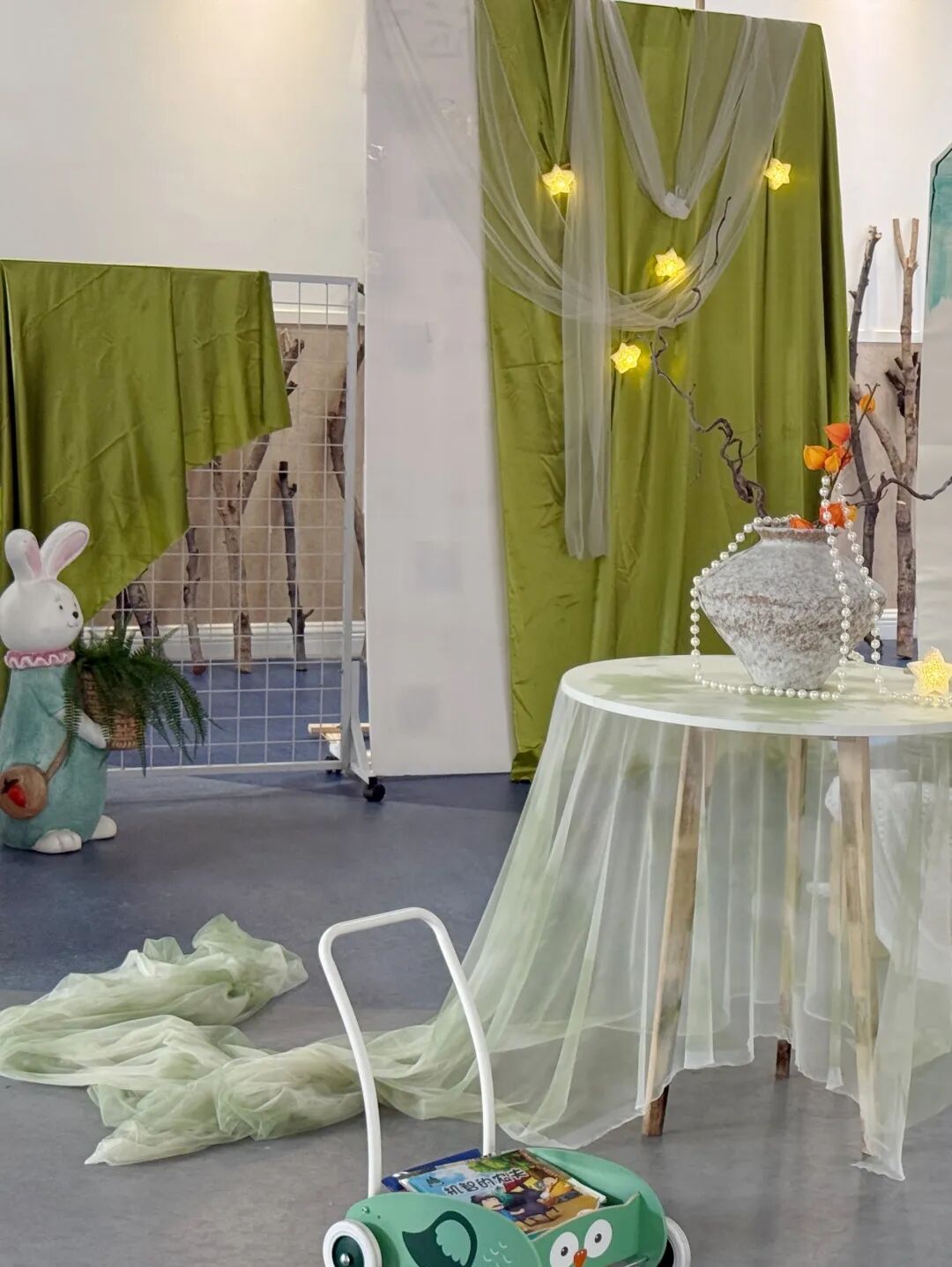绘本《桃花鱼婆婆》教学设计
【故事简介】
《桃花鱼婆婆》是儿童文学作家彭学军、青年插画师马鹏浩的最新作品。作品以湘西苗寨为背景,讲述了一群小孩子与一位会放蛊的巫婆之间的故事。巫婆名叫阿秀婆,因为会做好吃的桃花鱼,又被孩子们叫做桃花鱼婆婆。阿秀婆离群索居,人们见到她都避而远之,只有天真烂漫的孩子们和她形影不离。后来阿秀婆为了保护险些被野猪伤害的幺妹,奋不顾身将野猪引向悬崖……
【活动目标】
1、通过质疑、猜想、设置悬念等方法,激发学生阅读兴趣,产生阅读期待。
2、了解绘本故事的内容,体会桃花鱼婆婆与孩子之间的动人故事,感受桃花鱼婆婆的人物形象,并在阅读过程中习得阅读图画书的方法。
3、通过欣赏重点画面,观察细节,在师生共读、互动中培养孩子的想象、口语表达能力。
【活动过程】
一、谈话激趣 ,阅读封面。
1、在湖南省西部的大山之间散落着一些苗族寨子,这里充满着神秘和奇异。
2、今天这节课,我们就来阅读一本发生在苗寨的绘本故事,咱们先来仔细观察它的封面,你看到了什么?你想知道些什么?
3、观察前后蝴蝶页你都看到些什么?有什么不同?从书名页你看到了什么?
4、绘本真有意思,如果你用心观察,每一幅图都会说话呢!下面,让我们一起走进这个苗寨吧!
二、自读绘本,整体感知。
请你自己阅读这个故事,争取在6分钟之内读完。看看给你留下了什么印象?
师:刚才同学们读了这本书,给你留下了一个大致印象,其实绘本里还藏着很多秘密呢,让我们一起去发现。
三、师生共读,深入感悟
(一)感受苗寨风情,了解阅读方法
这就是苗寨(跨页一),请你仔细观察图,你发现了什么?
(引导学生按一定顺序观察这幅图)
师:我们刚刚从图当中观察到了这么多秘密,感受到了这是一个多么宁静和谐的苗寨,又从文字中知道了苗寨很小,房子很挤。这就是读绘本的方法,图文结合,会让你有更多的发现。
(二)深入感受阿秀婆的神秘可怕
1.我们在封面看到了阿秀婆的头,现在看到她的全身了(学生观察第二个跨页),给你留下什么印象?
2. 除了她的长相和穿着比较怪、让人害怕,还有哪些地方让人感觉神秘,可怕呢?除了这地方做了这个防止被施魔法的手势,还有哪有呢?请你静静地阅读第二个画面到第八个画面找一找。看完了同伴可以交流一下。
(预设:手势:跨页四、七;神秘,可怕的地方:跨页三、四)
3. 你认真观察图(跨页八),阿秀婆走进屋去,我们等了一节课那么久。那么久的时间,阿秀婆进屋去都做了什么?
(三)感受阿秀婆与孩子之间的爱
1.请你打开画面九,阿秀婆有这么可怕吗?我们来看看他做了什么就知道了。谁来给我读一读,此时你还觉得阿秀婆可怕吗?你有什么感受?
2. 阿秀婆指甲的变化就是人们对阿秀婆看法的变化,我们从孩子们的手势也能看出来,从这一画面后面,你会发现孩子们的这个手势是不是就没有了呢?在后面的阅读中,你可以留心看看。
3. 下面请你读一读这幅画面(指给学生看)到画面十四,找一找你从哪些地方感受到阿秀婆和孩子之间的爱?
(预设:跨页九、十、十一、十二、十三、十四)
4.(仔细观察跨页十五)为了引开野猪,阿秀婆奋不顾身地朝断崖的地方跑去,你觉得阿秀婆像( )一样快。(学生想象,训练表达)
追问:再仔细观察阿秀婆的眼神,你感受到了什么?
师:野猪跟着掉下了悬崖,我们得救了,阿秀婆呢?我们哪里都找不到她。嘴馋了,我们忍不住又去到阿秀婆家。
5.同学们,你觉得阿秀婆在家吗?他不在,那她又去了哪里呢?(让学生充分想象)
6. 孩子们期待着阿秀婆在家里给他们做好吃的桃花鱼,幺妹扛着烟杆,他们大步向阿秀婆家里走去……
Stude
A
Properties: Recorder, Overhead Projector and a map of world.
Teaching Objectives:
1. Practise listening ability.
2. Revise the grammar: the Comparative Degrees of Adjective and Adverbs
The Past Perfect Tense
Language Focus: Checkpoint 18
Teaching Procedures:
I. Showing the teaching aims
II. Revision
Check homework, then ask the students to read the partners’ homework to share with each other.
Revise the use of the Infinitive
III. leading in
T: Today we’ll learn something about Coco. Do you know where she is from?
IV. Listening practice
Play the tape or for the students to listen and find the answer, then look at the workbook, Exercise 1, go through the questions with the students and make sure they can understand what they mean. Play the tape again, let the students discuss their answers in pains before the teacher checks the answers with the whole class.
V. Presentation
Show the students a map of the world, and ask: What map is it? Help the students find “China” and “India” on the map. Let the students discuss the two countries: They are developing countries. They have a large population in the world.
Ask: What’s the population of China and what’s the population of India? Let the students read Part 2 and answer the questions. (China’s population is 1 328 000 000 and India’s population is 1 000 000 000). That’s to say India’s population is smaller than China’s .Ask the students to use the words in the box to complete the passage, then read together, finally ask the students to retell the text.
VI. Practice
Revise the Grammar: The Past Perfect Tense, give some examples:
1. He had left before his wife came back.
2. I remembered that Peter had already got a bike.
3. By the end of last month, he had learned 2000 new words.
4. When I got to the cinema, the film had begun.
Then ask the students to do Exercise 3. The answers are: 1 C 2 E 3 A 4 B 5 D. Let the students read these sentences together.
VII. Practice
Ask the students to do Exercise 4 first, then check the answers. The answers are: had, in, is, more, the, had, to, in, had, that, to, us, and, to
VIII. Workbook
Give the students five minutes to finish workbook. Do Exercises 1, 3 and 4. Then check the answers.
The answers to Exercise 1 are: took, went, found, was, called, told, had happened, said, would go, came, was found, checked, founded, said, stole, went, enjoyed, came, found, had stolen, had
The answers to Exercise 3 are: I worn out 2 try on 3 slow down 4 made up my mind 5 am pleased with 6 were angry with, deserve to 7 at least 8 as if 9 carried on
IX. Summary
Exercises in class
Fill in the blanks according to the text in this unit.
Lucy and Lily are___1___. They are living together___2___. But sometimes they fight. It doesn’t last too___3___. They___4___very well with each other again.
They look___5__, so it’s hard for people to recognize them: Who is Lucy___6__Lily. We always___7___mistakes. They feel___8__. They like most of the same things, for example: music, food and___9__. But Lily likes to___10__, Lucy likes to___11__, they don’t like the same colour,____12___. So they have some___13____Sometimes they disagree, but they never___14__. They love each other and they are___15___happy that they are twins.
Answers: 1.twins 2.most of the time 3.long 4.get on 5.the same 6.or 7.make 8. the same 9. books 10 .dance 11. sing 12. either 13. differences 14. fight 15.both
X. Homework
Prepare for the final examination.
Lesson 70 教学设计方案
Properties: Computer, Projector, PPT document provided.
Teaching Objectives:
1. Let the students understand the dialogue and learn new words.
2. Go over the Past Perfect Tense.
Language Focus:
New words: British, fail, summit, misty, mist
Useful expressions: disappear into, the first men to do tins, try to reach the top of
Teaching Procedures:
I. Showing the teaching aims
II. Revision
Ask the students to act out the dialogue is provided in Lesson 69-1.asf
III. Lead in
Give the students some information and pictures about Mount Qomolangma, and check their homework. Let them speak something about the history of climbing the Mount Qomolangma.
For example:
It was formed 60million years ago and ascends to the height of 8850. Surveyor General Andrew Waugh proposed to name the mountain Everest after his predecessor, George Everest. This name prevailed until today, although the mountain has two local names – Qomolangma in Tibetan, Sagarmatha in Nepali.
IV. Watch and listen
Ask the students to watch the flash Because it is there.swf which is provided. Listen the text carefully, and finish the questions:
True or False
1. Mount Qomolangma is the tallest mountain in the world. ( )
2. George Mallory is a professional (职业的) mountain climber. ( )
3. Mallory had tried four times to reach the top of the mountain. ( )
4. In 1921 he tried to climb the mountain for the first time. ( )
5. Edmund Hillary and Tenzing Norgay were thought to be the first men to reach the top of the mountain. ( )
6. Edmund Hillary found Mallory’s body in 1999. ( )
Answers:
1. √ 2. × 3. × 4. √ 5. √ 6. ×
V. Read the text
Let the students read the text carefully and grasp the main idea of this article. And find out what happened in different years (1921, 1922, 1924, 1953, 1999).
nne’s Best Friend Do you want a friend whom you could tell everything to, like your deepest feelings and thoughts? Or are you afraid that your friend would laugh at you, or would not understand what you are going through? Anne Frank wanted the first kind, so she made her diary her best friend. Anne lived in Amsterdam in the Netherlands during World War Ⅱ. Her family was Jewish so nearly twenty-five months before they were discovered. During that time the only true friend was her diary.
She said, ”I don’t want to set down a series of facts in a diary as most people do, but I want this diary itself to be my friend, and I shall call my friend Kitty.” Now read how she felt after being in the hiding place since July 1942. Thursday 15th June, 1944 Dear Kitty, I wonder if it’s because I haven’t been able to be outdoors for so long that I’ve grown so crazy about everything to do with nature. I can well remember that there was a time when a deep blue sky, the song of the birds, moonlight and flowers could never have kept me spellbound. That’s changed since I was here. …For example, one evening when it was so warm, I stayed awake on purpose until half past eleven in order to have a good look at the moon by my self. But as the moon gave far too much light, I didn’t dare open a window. Another time five months ago, I happened to be upstairs at dusk when the window was open. I didn’t go downstairs until the window bad to be shut. The dark, rainy evening, the wind, the thundering clouds held me entirely in their power; it was the first time in a year an
ts exercise, fit, strong, pollutionshare… with…, notice, pay attention to, signals, safety rules, helmets, light-colored, reflectors, in case of, first aid, call 120Stage 4:Post-readingFinish Ex.2 and a translation task.Stage 5:ProjectHow can we be safe on the road? Write a passage according to the information in 3, add your own ideas. The following words may help you.should (not)/must (not)/had better (not)play on the road; listen to music;look left/right; pay attention to;obey traffic rules; first aid;Stage 5:Summary and homework1. Summary:New words and phrases:truck, notice, safety,in a word, look out, pay attention toUseful expressions:Bicycle riding is good exercise.In a word, the best way to be safe is to be careful.Safety rules for bike riders:They must wear helmets to protect their heads.…, bicycle riders should know how to give first aid.2. Homework:a) Review the key point in Section C.(2) Complete the passage of Project.(3) Preview Section D. Collect information about bicycle races.V. Blackboard designSection CWords and expressionssafety, truck, notice, injury, signal, pay attention to, in case ofcan master the rules of changing original verbs into past tense, for example, learn-learnt, study-studied and so on.
Ability aims:
Students’ ability of listening will be improved and they can make a new conversation by using simple past tense.
Emotional aims:
Students will be interested in learning English grammar and they will have the courage to challenge the new things.
Teaching key points and difficult points:
Key points:
Students can master the rules of changing original verbs into past tense, for example, learn-learnt, study-studied and so on.
Ability aims:
Students’ ability of listening will be improved and they can make a new conversation by using simple past tense.
Emotional aims:
Students will be interested in learning English grammar and they will have the courage to challenge the new things.
Teaching key points and difficult points:
Key points:
Students can master the rules of changing original verbs into past tense.
Difficult points:
Students will use simple past tense to describe an unforgettable experience that happened in the past.
Teaching procedures:
Students can master the rules of changing original verbs into past tense, for example, learn-learnt, study-studied and so on.
Ability aims:
Students’ ability of listening will be improved and they can make a new conversation by using simple past tense.
Emotional aims:
Students will be interested in learning English grammar and they will have the courage to challenge the new things.
Teaching key points and difficult points:
Key points:
Students can master the rules of changing original verbs into past tense.
Difficult points:
Students will use simple past tense to describe an unforgettable experience that happened in the past.
Teaching procedures:
Step 1 Lead-in
Greet students and sing a song Yesterday once more.
Ask students the topic of this song then lead in the new class naturally.
(Justification: the song’s topic relates to the past and it is a very classic English song, so students will be drowned in the music even try to study this song.)
Step 2 Pre-listening
Give some examples to introduce the rules of changing original verbs into past tense.
Let students make some sentences to describe an experience of their own.
(Justification: students will be familiar with the grammar point and they can have a basic awareness of the English grammar.)
Step 3 While-lisening
1. Extensive listening
Listen to the tape for the first time and answer the quest
Unit 1 How do you study for a test?
Teaching aims:
Knowledge aim:
Students can accumulate some useful words through reading, such as frustrating, conversation and so on.
Students will learn more ways to learn English better.
Ability aim:
Students can use some basic reading strategies including skimming, scanning and prediction to read efficiently.
Emotional aim:
Students will be interested in learning English and can find the best way to learn English well.
Key points and difficult points:
Key points: Students can master some useful expressions and comprehend the content of this passage.
Difficult points: Students can master some useful reading strategies and put them into practice.
Teaching Aids: PPT. pictures
Teaching Procedures:
Step 1 lead in
1. Greeting with my students
2. Free talk
Let students talk about why they learn English freely and invite some students to share their idea with us.
S1: because it is very useful for us to communicate with foreigners…
S2: because we should have a good score in English examination.
By this way, teacher will lead students to think another question as they believed that English is very important in our life. “How can we learn English well?” then teacherwill lead in today’s topic “how do you learn best?”
Step 2 Pre-reading
Discussion and prediction
Teacher will encourage students to discuss with their partners about the way they usually use to study English, at the same time, let them predict what the author will tell us in this passage.
Step 3 While- reading
1. Global reading
Ask students to skim the passage and try to summarize the general idea of it. Then let students scan the passage for some specific information and answer the following questions,
“How many persons are mentioned in this passage?”
“How many ways do the characters mention in this passage?”
2. Detailed reading
Students will be required to read the passage again to finish the chart below the passage.
Step 4 post-reading
1. Deal with the language points
After students have finished reading, Teacher will ask them try to find the new words and expressions in the passage. They should try to learn them by themselves. Then we will deal them together.
2. Pair work
Students will work in pairs to do a survey by using the expressions on the textbook. Then they should finish the chart below the passage.
Summary and homework
Ask students to do a survey on more students about their ways of learning English.
Blackboard design
ion:
What are they talking about?
(Justification: students’ ability of getting main idea through extensive listening will be improved.)
2. Intensive listening
Listen to the tape one more time and answer the questions:
1. What does Lingling’s grandma do?
2. What does Lingling’s grandpa do?
3. Is Lingling’s grandpa learning English now?
(Justification: these questions can help students grasp some detailed information of Lingling’s family, and also, their listening ability will be improved.)
Step 4 Post-listening
Four students in a group, share an unforgettable experience with their partners. PaWoman :Good morning,sir!Can I help you?Dad: Yes,please. What w 1 you like,Ann?Ann : A l 2 bowl of noodles w 3 carrot and beef. I’m hungry.Dad: Anything to d 4 ?Ann: Yes. A glass of orange j 5 .Dad: OK. What a 6 you,Tom?Tom: I’m not h 7 .Just a b 8 of water.Dad: All right. And I’d l 9 a cup of tea.Woman :H 10 you are.Dad: Thank you.y attention to use the simple past tense. After 5minutes, some students will be invited to share in front of the class.
(Justification: this activity can help students improve their speaking ability, and can provide them a chance to apply the knowledge into real situation.)
Step 5 Summary and homework
Summary: Invite one student to summarize what we have learned today, and the teacher will give some help to complete.
Homework: Ask students to share the experience with their parents in English after class.
Blackboard design:
Step 1 Lead-in
Greet students and sing a song Yesterday once more.
Ask students the topic of this song then lead in the new class naturally.
(Justification: the song’s topic relates to the past and it is a very classic English song, so students will be drowned in the music even try to study this song.)
Step 2 Pre-listening
Give some examples to introduce the rules of changing original verbs into past tense.
Let students make some sentences to describe an experience of their own.
(Justification: students will be familiar with the grammar point and they can have a basic awareness of the English grammar.)
Step 3 While-lisening
1. Extensive listening
Listen to the tape for the first time and answer the question:
What are they talking about?
(Justification: students’ ability of getting main idea through extensive listening will be improved.)
2. Intensive listening
Listen to the tape one more time and answer the questions:
1. What does Lingling’s grandma do?
2. What does Lingling’s grandpa do?
3. Is Lingling’s grandpa learning English now?
(Justification: these questions can help students grasp some detailed information of Lingling’s family, and also, their listening ability will be improved.)
Step 4 Post-listening
Four students in a group, share an unforgettable experience with their partners. Pay attention to use the simple past tense. After 5minutes, some students will be invited to share in front of the class.
(Justification: this activity can help students improve their speaking ability, and can provide them a chance to apply the knowledge into real situation.)
Step 5 Summary and homework
Summary: Invite one student to summarize what we have learned today, and the teacher will give some help to complete.
Homework: Ask students to share the experience with their parents in English after class.
Blackboard design:
Students can master the rules of changing original verbs into past tense.
DifficThe teacher asks the students to read 1a and match the topic sentence with each paragraph. Then write a title for the passage in the box above.2. Read and understand. The teacher plays a flash about the text. After watching it, the students should find the answers to the questions in 1c.(1)What do people use bicycles for?(2)Why is bicycle riding good exercise?(3)How do bicycle riders protect their heads?(4) What must bicycle riders do when riding at night?(5)If a bicycle rider is badly hurt in a traffic accident, what should he / she do?3.Do some listening. Listen to 1a and find out ult points:
Students will use simple past tense to describe an unforgettable experience that happened in the past.
Teaching procedures:
Step 1 Lead-in
Greet students and sing a song Yesterday once more.
Ask students the topic of this song then lead in the new class naturally.
(Justification: the song’s topic relates to the past and it is a very classic English song, so students will be drowned in the music even try to study this song.)
Step 2 Pre-listening
Give some examples to introduce the rules of changing original verbs into past tense.
Let students make some sentences to describe an experience of their own.
(Justification: students will be familiar with the grammar point and they can have a basic awareness of the English grammar.)
Step 3 While-lisening
1. Extensive listening
Listen to the tape for the first time and answer the question:
What are they talking about?
(Justification: students’ ability of getting main idea through extensive listening will be improved.)
2. Intensive listening
Listen to the tape one more time and answer the questions:
1. What does Lingling’s grandma do?
2. What does Lingling’s grandpa do?
3. Is Lingling’s grandpa learning English now?
(Justification: these questions can help students grasp some detailed information of Lingling’s family, and also, their listening ability will be improved.)
Step 4 Post-listening
Four students in a group, share an unforgettable experience with their partners. Pay attention to use the simple past tense. After 5minutes, some students will be invited to share in front of the class.
(Justification: this activity can help students improve their speaking ability, and can provide them a chance to apply the knowledge into real situation.)
Step 5 Summary and homework
Summary: Invite one student to summarize what we have learned today, and the teacher will give some help to complete.
Homework: Ask students to share the experience with their parents in English after class.
Blackboard design:
阿秀婆到底去了哪里,你们想知道吗?下面就请贾老师用美术的语言来告诉我们吧!
翻开绘本 《桃花鱼婆婆》,就像摊开了一块蜡染的布。
看到“桃花鱼婆婆”,觉得有点邪气,和桃花搭不上边。
读完这个 邪而美的绘本,感受到一股神秘感,一丝震撼,确实非常回味。
先说说《桃花鱼婆婆》图画,很有特色,绘本整体色调接近传统蜡染布的 靛蓝色,结合了 湘西苗族的蜡染和苗绣形式来创作的,绘画者是采用蓝色彩铅模仿蜡染。
湘西蜡染布
因为,《桃花鱼婆婆》 故事本身带有浓郁的湘西乡土气息,湘西是个很神秘的地方, 湘西有三邪,其中之一就是 “放蛊”。
蛊在湘西地区俗称“草鬼”,相传它寄只附于女子身上,危害他人。那些所谓有蛊的妇女,被称为“ 草鬼婆”。
《桃花鱼婆婆》中的阿秀婆,据说就是“草鬼婆”, 也就是 巫婆。
大山里有一个小村寨,小村寨里有一条小溪沟,小溪沟里有好多好多的桃花鱼。可只有阿秀婆能抓到桃花鱼,据说她会念咒语。
到春天桃花开了的时候,阿秀婆用桃花鱼做成的酸鱼好吃得要命 ……
这个阿秀婆到底是不是坏人,有没有害人呢?
不剧透,自己看哟,享受下湘西的神秘感,毕竟是童书,也不会很吓人,请放心。
《桃花鱼婆婆》
画:彭学军
图:马鹏浩
蒲公英童书馆
我们的寨子很小,
房子都挤在一起,怕冷似的。
阿秀婆的房子不怕冷,她住在远远的山里。阿秀婆一年四季都穿着黑色大袍子,空空荡荡的。
她有一根很长的烟杆,黄铜的烟嘴儿。要是惹恼了她,那烟杆往头上一敲,只轻轻地一下,头上就会鼓起一个包,但比起阿秀婆的烟杆,我们更怕她 放蛊。
传说阿秀婆是巫婆,我们那里叫 草鬼婆。
放蛊就是施魔法,她会把我们变成什么呢?小动物还是小妖怪?
这是真的吗?没有人能告诉我们。反正,大人让我们离他远一点。
可是,我们没法离她远一点,因为她有一个黑陶罐,黑陶罐里有腌制的 桃花鱼。
春天桃花盛开的时候,阿秀婆屋子后头的小溪里。桃花鱼比天上的星星还多。
用桃花鱼做的酸鱼,是世界上最好吃的酸鱼。但没有人能捞到桃花鱼,除了阿秀婆。
有人说,她只在半夜捞鱼,念一段咒语,鱼儿们就排着队往她的罐子里钻。
嘴馋了,我们就去阿秀婆家讨鱼吃。
阿秀婆只顾抽烟,看也不看我们一眼。
终于,她放下烟杆,走出屋子。
好像等了一节课的时间,阿秀婆才抱着黑陶罐出来。一条,两条,三条 ……幺妹五条。
阿秀婆说:“幺妹最小,要多吃一点。”
其实我们都知道,那是因为幺妹没有爸爸,也没有妈妈。还有……
离开的时候,阿秀婆会站在那儿,看着我们走出好远好远。
秋天到了,我们会到山里找好吃的,野柿子,毛栗子。
如果是刚刚下过雨,还能采到一些小蘑菇呢。这些东西,我们都会放一点在阿秀婆的家门口。
每次阿秀婆都叮嘱我们不要进山里太深:“别到北山去,那里有野猪。”
进了山,我们越走越深,分不清东南西北了。
阿秀婆突然出现了,她朝着野猪大声叫喊。
她举起烟杆砸向野猪,野猪丢下我们,转身朝阿秀婆扑去。
阿秀婆朝着断崖的方向跑去。
呼~呼~
越跑越近,越追越近……
风把阿秀婆的长袍吹得鼓起来,
像打开的翅膀。
野猪掉下了悬崖。
阿秀婆呢?我们哪里也找不到她。
嘴馋了,我们忍不住又去到阿秀婆家。
—— 故事完 ——









